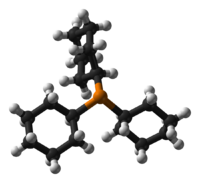- Tricyclohexylphosphine
-
Tricyclohexylphosphine 
 tricyclohexylphosphaneOther namestricyclohexylphosphine
tricyclohexylphosphaneOther namestricyclohexylphosphine
P(Cy)3
PCy3Identifiers CAS number 2622-14-2 Jmol-3D images Image 1 - C1(CCCCC1)P(C2CCCCC2)C3CCCCC3
- InChI=1/C18H33P/c1/h16-18H,1-15H2
Properties Molecular formula C18H33P Molar mass 280.43 g mol−1 Melting point 82 °C
Hazards Main hazards toxic  (verify) (what is:
(verify) (what is:  /
/ ?)
?)
Except where noted otherwise, data are given for materials in their standard state (at 25 °C, 100 kPa)Infobox references Tricyclohexylphosphine is the tertiary phosphine with the formula P(C6H11)3. Commonly used as a ligand in organometallic chemistry, it is often abbreviated to PCy3, where Cy stands for cyclohexyl. It is characterized by both high basicity (pKa = 9.7) and a large ligand cone angle.[1]
Important compounds containing P(Cy)3 ligands include the 2005 Nobel Prize-winning Grubbs' catalyst and the homogeneous hydrogenation catalyst Crabtree's catalyst.
References
- ^ R. C. Bush and R. J. Angelici (1988). "Phosphine basicities as determined by enthalpies of protonation". Inorg. Chem. 27 (4): 681–686. doi:10.1021/ic00277a022.
Categories:- Tertiary phosphines
Wikimedia Foundation. 2010.


